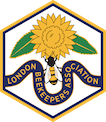
|
London Beekeepers' Association |

|
London Beekeepers' Association |
April in the Apiary[In the apiary, month by month.] Howard Nichols It is in April is that colony populations substantially increase and drones start to appear. There should normally be sufficient available forage for the bees to be self-sufficient if the weather holds good. Stores are currently higher than usual in my own hives due to the late nectar surplus in October. The most important job for the beekeeper in April, given the weather, is to ensure that the colony is not starving. Other jobs to doRemove mouseguards. Remove mouseguards and replace with a clean, sterilised entrance block. Mark the queen. If the queen is unmarked then this is an ideal time to find and mark her. The colony is now going to continue to expand in numbers up until July whereupon it will start to contract. Swarm control is considerably easier with a marked queen. Maintain records. Is the colony continuing to build up? A significant benefit of keeping colony records is that the number of frames of brood is recorded. Varroa mites. Check mite drop if not already done in March. 1st full inspection. If not done in March then the first full inspection and spring cleaning of the hive should be carried out. The first entry can then be made into the colony records. From then on regular inspections should be made. Inspecting a colonyWhen inspecting a colony, 5 questions should always be asked and actions taken if appropriate.
April is the month that the colonies "take off" for the season. I do hope you all have an enjoyable beekeeping season, that your colonies will thrive and that you will achieve your aims. |
©2025 London Beekeepers' Association |